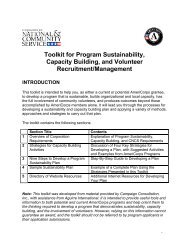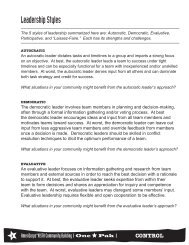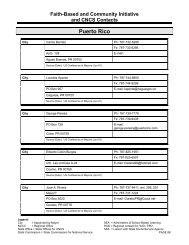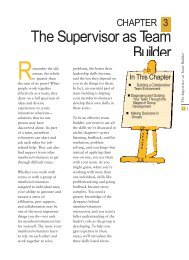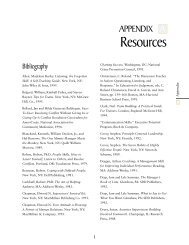MAKE IT LAST FOREVER: THE ... - National Service Resource Center
MAKE IT LAST FOREVER: THE ... - National Service Resource Center
MAKE IT LAST FOREVER: THE ... - National Service Resource Center
Create successful ePaper yourself
Turn your PDF publications into a flip-book with our unique Google optimized e-Paper software.
HOW DO CATEGORIES SUPPORT <strong>THE</strong> FUNCTION OF POWER?<br />
The six core categories of strategies which support those<br />
who have the power and authority to make decisions<br />
about how service-learning will operate in the school,<br />
district, or state educational system form the inner circle<br />
in the diagram to the right.<br />
Each of these six categories is then best supported by two<br />
other categories. For example, the development of servicelearning<br />
policy directly benefits from service-learning<br />
being part of the educational mission of the institution,<br />
and the development of such a mission rests in part on<br />
how future teachers are prepared to enter this profession.<br />
Those who are encouraged in college to see the<br />
educational value of service are likely to believe that<br />
service should be part of a school and district educational<br />
philosophy.<br />
In-Kind<br />
Faculty <strong>Service</strong>s<br />
Camaraderie<br />
Public<br />
Strategic Support<br />
Planning<br />
Links to<br />
Educational<br />
Standards<br />
Curricular<br />
Integration<br />
Logistical<br />
Structures Building<br />
Personnel<br />
POWER:<br />
Decision-making<br />
on how servicelearning<br />
will work<br />
School<br />
Structures<br />
Partnerships<br />
Professional Philosophy/<br />
Development State/District/<br />
Non-Profit<br />
Mission<br />
Organizational<br />
Personnel<br />
Pre-<strong>Service</strong><br />
Culture<br />
Evidence of Impact<br />
Education<br />
Each of the six core categories around the issue of power may depend primarily on the two categories in the outer edges of the diagram, but they also support<br />
and are supported by many other categories.<br />
CATEGORY SUPPORTS: SUPPORTED BY:<br />
Links to Educational Standards Student Assessment, Curricular Integration,<br />
Evidence of Impact<br />
Logistical Structures Curricular Integration, Project Evaluation,<br />
School Structures<br />
Building Personnel Logistical Structures, Strategic Planning,<br />
Project Evaluation<br />
Policy Links to Educational Standards, Funding,<br />
State/District/Non-Profit Personnel<br />
Policy<br />
Funding<br />
Policy, School Structures, Pre-<strong>Service</strong> Education, Peer Mentoring<br />
Building Personnel, School Structures, State/District/ Non-Profit Personnel<br />
State/District/Non-Profit Personnel<br />
Student Assessment, State/District/Non-Profit Personnel, Evidence of<br />
Impact<br />
School Structures Curricular Integration, Logistical Structures Philosophy/Mission, State/District/Personnel<br />
Curricular Integration Evidence of Impact, Links to Educational<br />
Standards<br />
<strong>Resource</strong>s, School Structures, Partnerships, Pre-<strong>Service</strong> Education,<br />
Logistical Structures<br />
110



